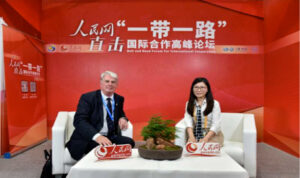Everything Under Heaven
China’s Belt and Road initiative is re-launched:
a much bolder vision than massive spending on infrastructure.
Steve Howard is Secretary General of the Global Foundation, Convenor of the Rome Roundtable, and International Advisor to the Asian Infrastructure Investment Bank. He has assisted China with its globalisation strategies over the past 20 years. Steve chaired the session on sustainable development at the Global Think Tank Summit of the Belt and Road Forum, held in Beijing on 14/15 May.
The Global Foundation will launch a global task force for China’s Belt and Road initiative. It will embrace China’s offer of global partnership, fully compatible with the Foundation’s ‘cooperative globalisation’ agenda, encouraging a dialogue between civilisations and identifying opportunities for action by business, academia and inter- and non-governmental bodies.
– – – – – –
Beijing, 14 May 2017
It had few comparators. A mini-Olympics, perhaps? Even by Chinese standards, something very big was in store. Under managed, pure blue skies, Beijing was dressed in its finery: slogans on banners hung everywhere and 70,000 roadside roses perfectly bloomed. Dawn wake-up calls ensured synchronised coach transfers to the splendidly secured national convention centre, where armies of volunteers ushered 1,500 invited world guests to their seats, hours ahead of the official starting time.
Then came the speech, a signal moment.
From the vast stage, Chinese President Xi Jinping spoke for 45 minutes, as he carefully laid out his refreshed vision, his recalibration of China’s intentions to go global, under the re-badged Belt and Road Initiative for International Co-operation.
Having spent the past 20 years working with China, advising its various organs in going global, having seen some of its earlier clumsiness out in the world and the fuzziness of its early efforts under the One Belt One Road banner, this speech, this recalibration was, in my view, a seminal moment for China and its relationship with the world.
The long road to the new world
First, a little context from experience. In 2001, at the same moment that China had agreed to join the WTO, the Global Foundation staged a related international roundtable in Beijing to discuss positive Asia Pacific futures. During that same visit which, incidentally, led to Australia securing its first LNG gas contract with China, the Foundation also convened a more formal, second track, bilateral meeting, where both delegations sat across the table from each other, and stony-faced Chinese interlocutors read hard-edged, pre-prepared texts, their idea of dialogue. Since then, we have seen the thaw, the emerging willingness of China to work more comfortably and openly within our and other second-track diplomacy frameworks, to test itself against wider, Western norms, at home and abroad, on a range of strategic issues.
Still, in 2008, we experienced China\’s continuing caution on sensitive issues, when it was reluctant at first to play a leading role in the creation of global climate change policy, only to be labelled a villain at the Copenhagen climate talks, after which it quickly changed tack, so that today, China is at the forefront of tackling domestic and global carbon emissions. Then, in 2011, when it might have grasped the leadership nettle and chosen to run the IMF, a major Bretton Woods institution, China again bided its time, instead preferring the appointment of Christine Lagarde, with one of its nationals this time appointed as her deputy.
Two years later, a switch was flicked. Almost out of the blue, in late 2013, President Xi announced that China had decided to both create and lead a brand new international institution, the Asian Infrastructure Investment Bank (AIIB) that, thanks to painstaking efforts inside and outside China, would eventually meet and even exceed previous standards of global governance, while being practically useful. His original vision for One Belt One Road, although less clear, was launched in parallel, around the same time. And finally, in October 2016, in Chongqing, 200 delegates from global political parties of all persuasions, along with a handful of other globalists, heard the leadership of the Communist Party of China formally extol the virtues and the Chinese Government\’s wholehearted commitment to economic globalisation. China had come a long way in the past 20 years.
Hardware, software and interdependence
So, back to President Xi\’s Belt and Road speech. At it\’s most fundamental level, it was certainly about hardware, of new roads and rail and ports, stretching across continents. It was a breathtakingly huge commitment to fund or co-finance a whole raft of new infrastructure, mainly to build actual connectivity between China and the rest of the world, along the old Silk Road and its maritime (and aerial and spatial) equivalents.
At the next level, that of software, it was also significant, as the speech committed to two-way partnerships, for the integration of systems, trade facilitation, of know-how and skills, of standards and rules. Therein lies great opportunity for those with the smarts to engage and benefit and, at the same time, a major challenge for governments and regulators to harmonise what will be quite different views about how international cooperation should be designed and run. In this respect, the AIIB could serve as a useful example and model of how best to shape this new software.
Overarching these practical elements of hardware and software, as impressive as they may have been, however, was the central and most profound element of President Xi\’s speech. Painting a backdrop of 2,000 years of history, interweaving China with the rest of the world, he spoke about the interdependence of cultures, values and civilisations, including religious traditions, and declared an historic moment of transition, this precise moment when China was officially announcing that it was no longer just dealing and trading with the world, as it has done for the past several hundred years. Rather, Xi\’s new intent was for a global China, fully integrated with a world of everything, under heaven.
A new era
International scepticism about China\’s international motives now seemed largely irrelevant. Right here and right now, the new challenge for the rest of the world, as for China itself is, at a minimum, to cope with the new global China and at best, to work closely with China to define and accommodate this new era and all of its consequences. The multipolar world has indeed arrived, taking real shape in front of our eyes. China has officially announced that it is now fully present at the international table.
Yes, President Xi\’s speech was also designed for domestic consumption, and it enjoyed blanket coverage for days, on all forms of media. But, whereas in the past, informed Chinese business leaders with Western instincts might have treated this as \’another announcement from the Government\’, this time the mood was different, one of genuine national pride: \’President Xi Jinping feels like he is our President\’. The Chinese people want to go global, too.
Locating the speech in a more historical context, a prominent Chinese banker, the founder of the Museums of Finance in China, explained the significance of the new Belt and Road strategy thus: \’We refer to it as the 5th wave of globalisation in history: the first wave was the Crusades; the second was Columbus; the third, the British Empire; the fourth, the Marshall Plan; the Belt and Road is the 5th wave\’.
China\’s intent, through Xi Jinping\’s Belt and Road strategy, needs to be understood well beyond bricks and mortar, concrete and steel, trade deals and investment flows. This may well have been, for China, its most significant international statement of intent since Admiral Zheng He’s fleet returned from its world explorations in the early 15th Century and the Emperor of the day decided that the Middle Kingdom had no more to gain from the outside world and the ships were burnt.
Where to from here?
Well, what to do? Even if China\’s vision is only partially realised, the new Belt and Road strategy, linked with China\’s bold commitment to economic globalisation, is a very big deal indeed.
The Global Foundation, which has long encouraged China\’s global emergence in a peaceful and collaborative way, is well-placed to further engage, on a number of levels. The Foundation’s mantra, of \’cooperative globalisation\’, has been honed by global leaders in various discussions across the world, most notably at its annual Rome Roundtable, and should fit neatly with the new China vision, encompassing \’everything under heaven\’. The necessary global dialogue between civilisations, cultures, values and religions, to resolve the means by which co-existence can occur, is a natural element of Foundation discourse, in which Chinese leaders are involved.
Underneath and in association with this high-level frame, practical actions can and should continue to emerge. The Foundation’s functional strategy of the past years, of \’Integrating AustralAsia\’, binding together Australia, China and Asia generally, through a strategy of seamless integration of hardware and software, of supply chains, for the exchange of food, resources, people and ideas, fits neatly with the strategy and rhetoric of the Belt and Road.
A task force for Belt and Road
The Global Foundation will launch a global task force to address China’s Belt and Road initiative. It will embrace China’s offer of global partnership, encouraging a dialogue between civilisations and identifying opportunities for action by business, academia and inter- and non-governmental bodies.
Invitations to contribute to the task force are being extended to the Global Foundation’s Advisory Council, key partners, corporate and university members, along with Patrons and other eminent persons. The task force will engage with various Chinese and international institutions and governments and inter-governmental organisations. A meeting of the task force will be held in Sydney on 3 August, featuring the participation of distinguished French internationalist, Mr Pascal Lamy.
A meeting date in China will be set for later in the year. The interim work of the task force will report to the next annual meeting of the Rome Roundtable, to be held in January 2018.

Links and references:
- The Text of the Belt and Road speech by President Xi Jinping, Beijing, 14 May 2017, may be found here
- Audio of Steve Howard’s introductory remarks as Chair of the Sustainable Development session, Beijing, 15 May 2017, may be found here
- Interviews of Steve Howard by Chinese media regarding Belt and Road:

